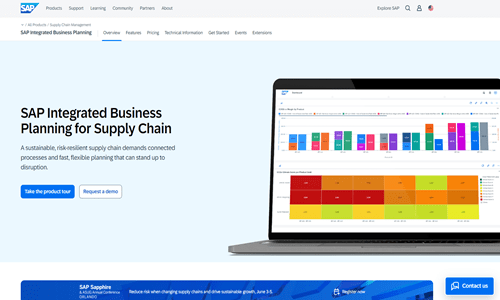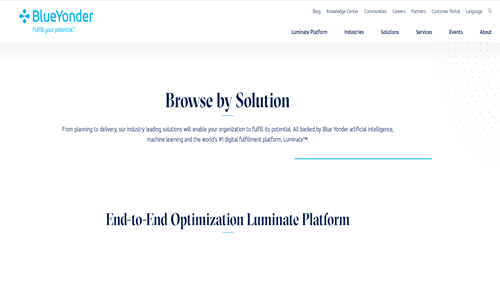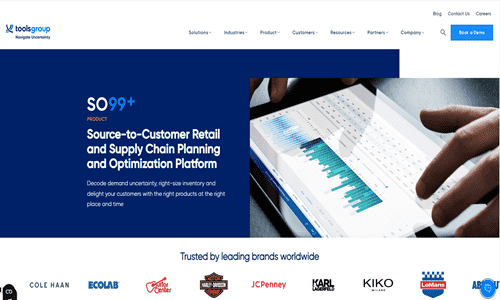
Supply Chain Planning Software: A Complete Guide
In the contemporary business landscape characterized by rapidity and globalization, proficient supply chain management has emerged as a crucial component of success for enterprises operating in diverse sectors. Firms must use cutting-edge technology to remain competitive and improve supply chain operations due to shifting market conditions, intricate supply networks, and rising client demands. Enter supply chain planning software, a potent tool created to streamline and automate supply chain operations, guaranteeing effective resource distribution, inventory control, and product and service delivery.
What is Supply Chain Planning Software?
A complete set of tools and applications known as supply chain planning software helps businesses organize, oversee, and maximize their whole supply chain network. It includes several modules and features that address several facets of supply chain management, including supplier cooperation, production planning, inventory optimization, demand forecasting, and transportation management.
Benefits of Supply Chain Planning Software
Supply chain planning software offers a lot to companies looking to improve their competitive edge and streamline processes. Here are a few main benefits:
Improved Efficiency:
Software for supply chain planning automates and simplifies several tasks, including distribution planning, production scheduling, inventory control, and demand forecasting. Businesses can increase productivity and run more efficiently by eliminating manual chores and minimizing human error.
Enhanced Visibility:
Supply chain planning software allows for real-time visibility into inventory levels, production plans, and transportation routes throughout the supply chain. With this information, companies may spot bottlenecks, foresee disruptions, and decide wisely to streamline processes and successfully satisfy client requests.
Optimized Inventory Management:
Using supply chain planning software, businesses can optimize inventory management to reduce carrying costs and guarantee enough product availability to fulfill consumer demand. Thanks to advanced forecasting algorithms and demand planning capabilities, businesses may reduce stockouts and overstock situations by precisely predicting demand patterns and adjusting inventory levels in response.
Cost Reduction:
Supply chain planning software helps businesses reduce operating expenses and improve their bottom line by optimizing inventory levels, minimizing transportation costs, and improving overall supply chain efficiency. Additionally, businesses can significantly reduce costs over time by identifying cost-saving opportunities and optimizing resource utilization.
Improved customer service:
Businesses can improve customer service by using supply chain planning software to ensure timely product delivery, save lead times, and increase order fulfillment accuracy. By continually satisfying consumer expectations, businesses can improve customer happiness, loyalty, and retention, ultimately leading to long-term growth and profitability.
Adaptability and Agility:
Supply chain planning software gives companies the flexibility and agility to adjust to shifting consumer tastes, market conditions, and supply chain interruptions in today’s fast-paced business environment. With access to real-time data and sophisticated analytics capabilities, businesses can quickly respond to unforeseen occurrences, reduce risks, and seize new possibilities.
Strategic Decision-Making:
Businesses may enhance strategic decision-making with data-driven analytics and actionable insights from supply chain planning software. By examining key performance indicators, spotting trends, and running various scenarios, businesses may optimize their supply chain strategy, distribute resources efficiently, and promote continuous improvement.
Key Features of Supply Chain Planning Software
Numerous supply chain planning software capabilities are intended to optimize and streamline different aspects of the supply chain operation. The following are essential characteristics of supply chain software:
Demand Forecasting:
Businesses can forecast future demand for goods and services using sophisticated demand forecasting tools. These tools take into account market trends, historical data, and other pertinent variables. Precise demand projections assist companies in efficiently meeting consumer demand by optimizing inventory levels, manufacturing schedules, and resource allocation.
Inventory Optimization:
Companies can minimize carrying costs and stockouts by optimizing their inventory levels to balance supply and demand by utilizing supply chain planning software. Inventory modeling, safety stock calculations, reorder point optimization, and inventory segmentation based on variables like lead times and demand variability are some of the characteristics of inventory optimization.
Production Planning and Scheduling:
These features enable businesses to plan and schedule production activities efficiently to meet customer demand while maximizing resource utilization and minimizing production costs. Production planning and scheduling capabilities include capacity planning, resource allocation, scheduling algorithms, and production order management.
Supply Planning:
These features help businesses optimize their supply chain operations by ensuring the timely availability of raw materials, components, and finished goods. This planning encompasses supplier management, procurement planning, lead time management, and supply chain collaboration to minimize supply chain disruptions and optimize inventory levels.
Distribution Planning:
By optimizing their distribution networks and transportation routes using distribution planning skills, businesses can minimize shipping costs, shorten lead times, and increase order fulfillment efficiency. To simplify logistical operations, distribution planning functions include carrier selection, load planning, route optimization, and transportation management.
Collaborative Planning and Forecasting:
Supply chain planning software facilitates collaboration and communication among stakeholders, including suppliers, manufacturers, distributors, and retailers. Collaborative planning and forecasting features enable real-time data sharing, demand visibility, and consensus forecasting to align supply chain activities and improve overall performance.
Scenario Analysis and Simulation:
These characteristics enable companies to run simulations and “what-if” analyses to assess the possible effects of various events, disruptions, and supply chain strategies. By using scenario analysis capabilities, businesses may evaluate risks, spot opportunities, and make well-informed decisions to reduce risks and seize opportunities.
Analytics and Reporting:
To track key performance indicators, monitor supply chain performance, and obtain useful insights into supply chain operations, supply chain planning software offers sophisticated analytics and reporting features to enable data-driven decision-making and continuous improvement activities, analytics, and reporting capabilities, including dashboards, data visualization tools, and predictive analytics.
Factors to Consider When Choosing Supply Chain Planning Software
When choosing supply chain planning software, several things should be considered to ensure your chosen program will meet your company’s goals and demands. Here are some important things to think about:
Scalability:
Select software for supply chain planning that will grow with your company. Ensure the program accepts more users, manages growing data quantities, and supports intricate supply chain procedures without sacrificing functionality or performance.
Integration Capabilities:
Consider the software’s compatibility with current systems, including warehouse management systems, CRM (customer relationship management), and ERP (enterprise resource planning). Seamless integration allows data synchronization and exchange across many systems, making possible process automation and end-to-end visibility.
Functionality and Features:
Assess the supply chain planning software’s features and functionality to ensure it meets your unique needs. Demand forecasting, inventory optimization, production scheduling, distribution planning, collaboration tools, analytics, and reporting capabilities are important elements to consider.
Usability and user experience:
Select supply chain planning software with a well-designed interface to make it easy to use and navigate. Software should be intuitive and user-friendly. User adoption and productivity will rise throughout your company with an intuitive software solution.
Customization and Flexibility:
Seek supply chain planning software with flexibility and customization choices to fit your business needs and operations. The software can effectively handle the difficulties facing your firm and support your strategic objectives if it can be tailored to meet your specific demands.
Support and Training:
Consider the degree of assistance and training the software manufacturer provides to ensure the program’s successful implementation and optimization. Seek suppliers to help you with the software installation and usage lifecycle by offering thorough training courses, user manuals, documentation, and continuous support.
Cost and ROI:
Evaluate the total cost of ownership (TCO) of the supply chain planning software, including upfront license fees, implementation costs, maintenance fees, and ongoing support costs. Compare the software’s cost against the expected return on investment (ROI) to ensure it delivers value and aligns with your budgetary constraints.
Vendor Reputation and Reliability:
Examine the software vendor’s standing and past performance to ensure they are dependable, solvent, and dedicated to meeting client needs. Seek suppliers with a track record of effective implementations, happy clients, and continuous product development.
Top Supply Chain Planning Software
Oracle SCM Cloud

Oracle SCM Cloud is a comprehensive software solution for supply chain planning and offers cutting-edge features for demand planning, inventory optimization, supply planning, and manufacturing planning. With its end-to-end visibility and control over supply chain activities, businesses can increase customer happiness, cut costs, and improve efficiency.
Pros:
- Robust functionality for demand forecasting, inventory management, and production planning.
- Scalable and adaptable to suit the requirements of companies in various sectors and sizes.
- Integration for smooth data interchange and process automation with other Oracle Cloud apps and external systems.
Cons:
- High upfront costs and ongoing subscription fees may be prohibitive for small and midsize businesses.
- The complexity of implementation and customization may require dedicated resources and expertise.
Services Provided:
Demand planning, inventory optimization, supply planning, manufacturing planning, collaboration tools, analytics, and reporting.
Pricing Package:
Oracle SCM Cloud provides subscription-based pricing customized to meet each customer’s unique needs and specifications. For information on prices, speak with Oracle sales.
SAP Integrated Business Planning (IBP)

SAP Integrated Business Planning (IBP) is a cloud-based supply chain planning software program that offers advanced features for demand planning, inventory optimization, supply chain cooperation, and predictive analytics. It helps companies make better decisions, increase business agility, and foster innovation in their supply chain operations.
Pros:
- Comprehensive supply chain planning functionalities cover demand, inventory, and supply planning.
- Seamless integration with SAP ERP systems and other SAP solutions for end-to-end supply chain management.
- She advanced predictive analytics and machine learning capabilities for better forecasting and decision support.
Cons:
- High implementation costs and complexity may require significant time and resources.
- The steeper learning curve is for users unfamiliar with SAP systems and terminology.
Services Provided:
Demand planning, inventory optimization, supply planning, collaboration tools, predictive analytics, and reporting.
Pricing Package:
SAP IBP offers subscription-based pricing, with pricing determined based on the specific modules and features selected. Contact SAP sales for pricing details.
JDA Supply Chain Planning

One of the top supply chain planning software programs is JDA Supply Chain Planning, which provides a full range of features for supply planning, demand planning, inventory optimization, and sales and operations planning (S&OP). It helps companies plan, make better decisions, and streamline their supply chain operations to promote corporate growth and profitability.
Pros:
- Extensive functionality for demand forecasting, inventory management, and supply chain optimization.
- Flexible and scalable to meet the needs of businesses across different industries and geographies.
- Integration with other JDA and third-party solutions for seamless data exchange and interoperability.
Cons:
- Implementation and customization may require specialized skills and expertise.
- Prices could be higher than some rivals, particularly for smaller companies.
Services Provided:
Demand planning, inventory optimization, supply planning, sales and operations planning (S&OP), collaboration tools, analytics, and reporting.
Pricing Package:
Subscription-based pricing is available from JDA Supply Chain Planning, with prices catered to each client’s unique demands and specifications. For information on prices, speak with JDA sales.
Kinaxis RapidResponse

A cloud-based software platform for supply chain planning, Kinaxis RapidResponse provides cutting-edge features for inventory optimization, demand planning, supply chain visibility, and supply chain collaboration. Businesses can promptly handle disturbances and seize opportunities using the real-time data they offer about supply chain performance.
Pros:
- Comprehensive supply chain planning functionality covers demand, inventory, and supply planning.
- Real-time data synchronization and analytics for proactive decision-making and response to changing market conditions.
- Flexible deployment options, including cloud-based and on-premises solutions, are available to suit the needs of different businesses.
Cons:
- Implementation may require significant time and resources, especially for complex supply chains.
- Prices could be higher than some rivals, particularly for smaller companies.
Services Provided:
Demand planning, inventory optimization, supply planning, supply chain visibility, collaboration tools, analytics, and reporting.
Pricing Package:
Kinaxis RapidResponse offers subscription-based pricing, with pricing determined based on the specific modules and features selected. Contact Kinaxis sales for pricing details.
ToolsGroup SO99+

ToolsGroup SO99+ is an AI-driven supply chain planning software solution that offers advanced demand forecasting, inventory optimization, and supply chain optimization capabilities. It leverages machine learning algorithms and probabilistic forecasting techniques to improve forecast accuracy, optimize inventory levels, and enhance supply chain performance.
Pros:
- Advanced AI and machine learning capabilities for demand forecasting and inventory optimization.
- Scaleable and adaptable to accommodate the necessities of corporations across all sectors and sizes.
- Integration with ERP systems and other enterprise applications for seamless data exchange and process automation.
Cons:
- The steeper learning curve is for users unfamiliar with AI and machine learning concepts.
- Implementation may require specialized skills and expertise in supply chain planning and optimization.
Services Provided:
Demand forecasting, inventory optimization, supply chain planning, collaboration tools, analytics, and reporting.
Pricing Package:
ToolsGroup SO99+ provides subscription-based pricing customized to meet each customer’s unique needs and specifications. For pricing information, contact ToolsGroup sales.
Implementation Process of Supply Chain Planning Software
The implementation process usually entails multiple crucial components to guarantee a business’s successful deployment and adoption of supply chain software. An outline of the standard implementation procedure is provided below:
Requirement Analysis:
The organization’s supply chain goals, processes, and needs must be thoroughly analyzed as the initial step in the implementation process. This entails getting feedback from important parties, including planners, supply chain managers, and IT specialists, to comprehend the particular requirements and difficulties the software solution must solve.
Software Selection:
Based on the requirement analysis, the organization selects a suitable supply chain planning software solution that aligns with its needs, objectives, and budget. This may involve evaluating multiple software vendors, conducting product demonstrations, and comparing features, functionalities, and pricing packages to make an informed decision.
Planning and preparation:
Once the software solution has been selected, the organization begins the planning and preparation phase of the implementation process. This involves defining project goals, timelines, and milestones and allocating resources, budget, and personnel for the implementation project. A project team may be established to oversee the implementation process and ensure coordination among different stakeholders.
Configuration and Customization:
The next step is configuring and customizing the supply chain planning software to meet the organization’s specific requirements and preferences. This may involve setting up master data, defining planning parameters, configuring workflows, and integrating the software with existing systems and databases. Customizations may also be made to tailor the software to the organization’s unique supply chain processes and workflows.
Data Migration:
Data migration involves transferring relevant data from existing systems, spreadsheets, or databases to the new supply chain planning software solution. This data may include product, customer, supplier, historical sales, and inventory data. Before migration, data cleansing and validation may be performed to ensure data accuracy and integrity.
Training and Education:
End users, administrators, and IT support personnel all participate in training and education programs to guarantee the supply chain planning software is successfully adopted and used. Training sessions may cover software functionality, navigation, best practices, and troubleshooting. Online resources, tutorials, and user manuals might facilitate continued education and skill improvement.
Pilot Testing:
A pilot testing phase is carried out before full deployment to verify the supply chain planning software’s performance and functionality in an actual setting. This entails testing important features, workflows, and situations to find any problems or potential areas for improvement. Before the program is fully rolled out, input from pilot users is gathered and used to adjust the settings and fix any problems.
Deployment and Go-Live:
Once pilot testing is complete and necessary adjustments have been made, the supply chain planning software is deployed for production use. This involves migrating users, processes, and data to the live environment and ensuring the software is fully operational and accessible to end-users. A formal go-live process may be conducted to mark the official launch of the software solution.
Post-Implementation Support and Optimization:
Once implemented, continuous support and optimization initiatives are essential to guarantee the supply chain planning software’s continuous success and efficacy. This could entail offering technical assistance, responding to users’ queries and problems, monitoring system performance, and applying updates and improvements to the software as needed. It’s also possible to perform routine assessments and evaluations to find areas for further optimization and development.
Future Trends in Supply Chain Planning Software
Technological advancements, evolving business needs, and changing market dynamics shape future supply chain planning software. Here are some key trends expected to influence the future of this software:
AI and machine learning:
- Integration of artificial intelligence (AI) and machine learning algorithms.
- AI-driven forecasting models, predictive analytics, and optimization algorithms.
- More precise demand forecasting, inventory planning, and supply chain optimization.
- It has enhanced productivity and decision-making.
Predictive and Prescriptive Analytics:
- Addition of prescriptive and predictive analytics features.
- Forecasting demand and spotting possible hazards and opportunities.
- Suggesting optimal courses of action.
- Proactive handling of supply chain disruptions, risk reduction, and trend capitalization.
Real-time Visibility and Collaboration:
- Enhanced real-time visibility into supply chain operations.
- Analyzing inventory levels, monitoring order status, and spotting possible bottlenecks or delays.
- Collaborative planning and execution capabilities.
- Greater agility and responsiveness to customer demands.
- Seamless communication and collaboration among supply chain partners.
Supply Chain Network Optimization:
- Support for more sophisticated network optimization features.
- Multi-tier supply chain modeling, network design, and scenario analysis.
- Optimization of supply chain networks for resilience, sustainability, and cost-effectiveness.
- Consideration of lead times, transportation costs, and carbon footprint.
Digital Twins and Simulation:
- Increased prevalence of digital twins and simulation techniques.
- Creation of virtual replicas of supply chain operations.
- Scenario testing, predictive modeling, and optimization of supply chain processes.
- Evaluate the impact of different strategies and decisions on supply chain performance before implementation.
Blockchain Technology:
- Increased integration of blockchain technology.
- Safe, transparent tracking of products and transactions through the supply chain.
- Boosting product authenticity, increasing traceability, and reducing the risk of fraud or counterfeiting.
- Enhanced supply chain trust and responsibility.
Sustainability and Environmental Impact:
- Incorporation of more sustainability-focused features and metrics.
- Tools for assessing the environmental impact of supply chain operations.
- Optimization of transportation routes for fuel efficiency.
- Sourcing materials from eco-friendly suppliers.
- Helping businesses reduce their environmental footprint and achieve sustainability goals.
Edge Computing and IoT Integration:
- Integration of edge computing and Internet of Things (IoT) devices.
- Real-time data collection and analysis at the edge of the network.
- Faster decision-making, improved asset tracking, and greater visibility into supply chain processes.
- Enhanced capabilities, particularly in remote or resource-constrained environments.
Cost Considerations of Supply Chain Planning Software
When considering the cost of this software, several factors must be trusted to ensure an accurate assessment and budget allocation. Here are some key cost considerations:
Software Licensing:
Licensing fees are frequently included in the price of supply chain planning software. They can vary depending on various criteria, including the number of users, modules used, and features needed. Different licensing models are available, such as upfront one-time fees, usage-based or subscription-based pricing.
Implementation and Deployment Costs:
Implementation and deployment costs encompass expenses related to software setup, configuration, customization, and integration with existing systems. This may include hiring consultants, training staff, and allocating resources for data migration and system testing.
Infrastructure and Hosting Fees:
Depending on the deployment model (e.g., on-premises, cloud-based, or hybrid), additional costs may be associated with infrastructure and hosting. Cloud-based solutions typically involve recurring subscription fees for hosting services, while on-premises solutions may require investments in hardware, servers, and IT infrastructure.
Maintenance and Support Fees:
Maintenance and support fees cover ongoing software updates, bug fixes, and technical support services the software vendor provides. These fees may be charged annually or regularly and are essential for ensuring the software’s continued performance and reliability.
Training and education expenses:
Training and education expenses include the cost of end-users, administrators, and IT support staff using the supply chain planning software effectively. This may involve conducting training sessions, providing user documentation, and offering online resources and support materials.
Integration Costs:
Integration costs refer to expenses related to integrating the supply chain planning software with other systems, such as ERP, CRM, and warehouse management systems. This may involve custom development work, data mapping, and API integration to ensure seamless data exchange and system interoperability.
Consulting Services:
Businesses may pay consulting fees for professional advice, guidance, and help during software selection, deployment, and optimization. The software vendor or outside consultants may offer consulting services, which can speed up the deployment process and increase the return on investment.
Total Cost of Ownership (TCO):
It is important to consider the total cost of ownership (TCO) of the supply chain planning software over its entire lifecycle, including upfront costs, ongoing expenses, and potential cost savings or benefits realized. Calculating TCO allows businesses to make informed decisions and evaluate the software solution’s long-term value proposition.
FAQs
Is supply chain software suitable for small and medium-sized businesses?
Many software vendors provide scalable options that meet the spending limits and needs of small and medium-sized businesses (SMEs).
How does supply chain software integrate with existing systems?
Most reputable supply chain software solutions offer integration capabilities with popular enterprise systems such as ERP, CRM, and WMS through standard interfaces or custom integrations.
Can supply chain software handle multi-site and global operations?
Absolutely. Advanced supply chain planning software is designed to manage complex, multi-site, and global supply chain networks, providing visibility and coordination across multiple locations.
How secure is sensitive data within supply chain planning software?
Reputable software vendors prioritize data security and compliance, implementing strong safeguards such as encryption, access controls, and compliance with pertinent industry standards and laws.
How long does it typically take to implement supply chain software?
The implementation timeline may change depending on the extent of the project, the degree of customization needed, and the complexity of your supply chain processes. Large-scale deployments typically require several months to more than a year for implementation.
Conclusion
In conclusion, supply chain planning software is an indispensable tool for modern businesses aiming to optimize their supply chain operations, enhance efficiency, and maintain a competitive edge. With advanced demand forecasting, inventory management, production planning, and supply chain collaboration capabilities, this software enables organizations to make data-driven decisions, reduce costs, and improve customer satisfaction. As technology evolves, incorporating trends such as AI, machine learning, and real-time analytics, supply chain software will only become more critical for businesses striving to navigate the complexities of the global marketplace. Investing in the right supply chain software can significantly improve operational performance, agility, and overall business success.




